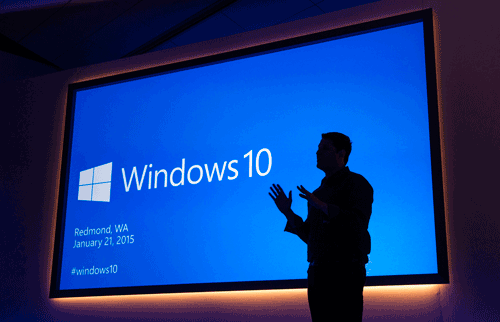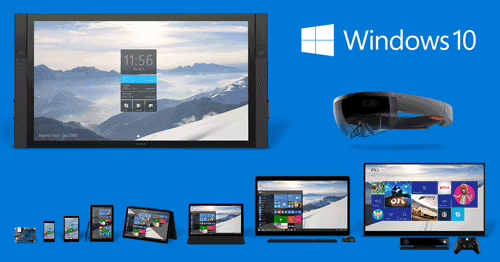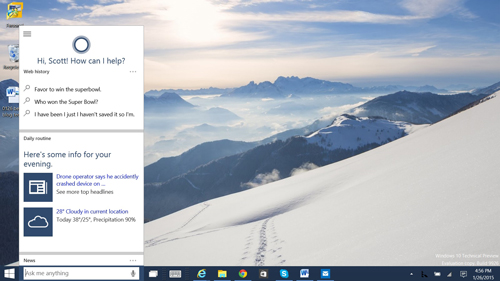In-Depth
10 Ways Windows 10 Will Affect Microsoft Partners
Everything will change for the Microsoft ecosystem when the next client OS ships. Here's a feature-by-feature guide to what specific partner types should expect from Windows 10.
To say Microsoft dropped a bombshell with its raft of Windows 10 revelations at the beginning of this year would be an understatement. For the Microsoft ecosystem, the changes in Windows 10 are like a series of low concussions in the distance. The Microsoft partner community has six months or so to get ready for the challenges and opportunities before Windows 10 ships, but the time to start thinking about strategic responses is, well, yesterday.
Here are 10 significant changes in Windows 10 that shake up the way Microsoft partners have done business.
1. Free Windows Upgrades
Partners Most Affected: LSPs, Open Licensing
Windows 10 will be a free upgrade for many Windows users when it becomes generally available as a service. Maybe the industry has been pushing Microsoft in this direction for some time, but it was still a shock to hear Microsoft Executive Vice President of Operating Systems Terry Myerson on Jan. 21 announce, in different words, that Microsoft was going to blow a giant hole in its own traditional revenue model. The path of that revenue hole continues through to the balance sheets of licensing solution providers (LSPs) and open licensing partners who monetize resales of Windows clients.
The free upgrade offer is limited, but still covers a broad swath of customers. It includes Windows 7, Windows 8 and Windows 8.1 for consumer versions and the Pro versions commonly used by small business customers.
To encourage users to move quickly to Windows 10, the free upgrade offer, for now, will only be available for the first year of Windows 10 availability. Once on Windows 10, customers will be able to upgrade to the latest version of Windows using the new Windows-as-a-Service approach through the entire lifetime of the device, although Microsoft had indicated back in January that it was still working out how to define this device lifetime qualification.
While Enterprise edition users will still be asked to pay for upgrades, possibly through Software Assurance or other means, getting any money for an OS that's now viewed as free for most users doesn't look like a viable long-term strategy.
Anthony Clendenen, a solutions architect for En Pointe Technologies, says the industry pressure must have weighed heavily on Microsoft for it to make such a consequential move. "For Microsoft, they've got a great revenue stream in Windows still, but it's going away," he says. "We can talk about the number of Android devices versus Windows devices..."
Instead, the company is eyeing revenue streams outside of Windows. "They'll make their money from people working on computers rather than people playing on computers," Clendenen said.
Asked during an investor call about how Microsoft's cross-platform moves and free upgrade offer for Windows help Microsoft as a business, Microsoft CEO Satya Nadella sounded similar themes.
"At the highest level our strategy here is to make sure that the Microsoft Services, i.e., cloud services, be it Azure, Office 365, CRM Online, or Enterprise Mobility Suite [EMS], are covering all the devices out there in the marketplace, so that way we maximize the opportunity we have for each of these subscription- and capacity-based services. So that's sort of the core rationale for why we are doing cross-platform," Nadella said. "So the best way to measure our progress is Office 365 subscription growth, Azure growth and EMS growth."
 Microsoft EVP of Operating Systems Terry Myerson reveals Windows 10 will be a free upgrade for many Windows users.
Microsoft EVP of Operating Systems Terry Myerson reveals Windows 10 will be a free upgrade for many Windows users.
2. Service Branches
Partners Most Affected: LSPs, MSPs
Microsoft plans to introduce a new "service branches" approach to software updates when it launches Windows 10 as a service. Using Windows as a service suggests that organizations and individuals would be exposed to faster OS updates from Microsoft. For many organizations, getting faster Windows updates isn't optimal, as they typically value maintaining stable computing environments over new software features.
Microsoft is currently developing options for organizations managing Windows 10 as a service, and managing these options on behalf of customers could become an important business for LSPs and managed services providers (MSPs). Details are sketchy, but Jim Alkove, a leader on the Windows Enterprise Program Management team, laid out Microsoft's current plans in a blog entry.
According to Alkove, Microsoft will have two "servicing branches" for organizations using Windows 10 that will give them greater control over the update process. The two branches are Long Term Servicing branches and a Current branch for Business option.
The Long Term Servicing branches are designed for organizations with mission-critical environments. They'll permit organizations to get Windows 10 security updates while also deferring software feature changes, apparently throughout the full 10 years of the Windows 10 product lifecycle. The Microsoft product lifecycle for enterprise products typically consists of five years of mainstream support plus another five years of extended support.
The Current branch for Business servicing approach with Windows 10 is also designed for businesses and enterprises. It also will deliver security updates to Windows 10 workstations, but it will delay the delivery of OS feature updates somewhat. It's not really clear how long the delivery of features will get delayed, but Alkove said that this approach would deliver "feature updates after their quality and application compatibility has been assessed in the consumer market."
It's unclear where Software Assurance fits into all this. "For companies that require these [Windows 10] enterprise-grade capabilities, Windows Software Assurance (SA) will continue to offer the best and most comprehensive benefits," Alkove wrote, but offered no further clarification. Of course, the Microsoft SA program for Windows promises no-cost upgrades to the next Windows release within a specific annuity contract period, but Alkove seemed to be implying that enterprise Windows 10 management capabilities might be tied to paying for SA coverage, which would be a new stipulation for IT shops.
In general, Microsoft left open the possibility that organizations will have to pay extra to use the service branch options with Windows 10, while not supplying the exact details.
3. New PC Refresh Dynamics
Partners Most Affected: OEMs, Distributors
The PC refresh cycle at the time of a new Windows release is one of the great spectacles of the tech industry. Or, at least, it was. Microsoft's decision to provide a lot of free routes to Windows 10 upgrades, and to make those system requirements pretty basic, makes the whole refresh cycle squirrelly for the Windows 10 release time frame and uncertain forever after. Look for hardware innovation by PC vendors to become much less coupled to Windows release schedules in the future.
4. Containers and Mobility Management
Partners Most Affected: Solution Providers, MSPs
Improving the mobile device management (MDM) experience is a key focus for Microsoft with Windows 10 features that will light up with System Center Configuration Manager and Intune.
Much of Redmond's MDM efforts are focused on the use of container technology, which provides a consistent interface for managing devices. In a public appearance in January, Brad Anderson, Microsoft corporate vice president for Enterprise Mobility, noted that Apple Inc. has put an MDM layer into its Mac OS, which is the same sort of thing Microsoft has been doing with Windows 10.
"If you take a look at what we're going to be shipping with Windows 10, the MDM layer that my team built that's available in Windows 8 will actually be a consistent layer across all devices, all form factors and all of the different Windows operating systems and devices," Anderson said.
He added that since Microsoft has built containers for iOS and Android, it has recognized that "there are some things that you can do only when you are the operating system vendor" to make things easier for end users. Anderson's team has specifically focused on building "data leakage protections" into Windows 10.
"I think that Microsoft, with Windows [10], will be the first operating system that really delivers a really capable and very easy to use data leakage protection solution by the container in the operating system," Anderson said.
On iOS devices today, containers are used to separate corporate content from personal content. It's done by blocking the sharing of content between corporate apps and personal apps, Anderson explained. When a user tries to paste content from a consumer app, the paste option doesn't appear when using today's iOS devices, Anderson said. In Windows 10, a dialog box will pop up telling users that the paste action is restricted. Windows 10 will include an override button, but the user will get informed that IT will log the paste attempt if that's tried. That Windows 10 capability, making things easier for end users, is an example of why having access to the OS is important, Anderson explained.
Microsoft plans to "light up" this container technology in Intune and Configuration Manager when Windows 10 is released. So far, Microsoft has seen "very few issues with [Configuration Manager] 2012 and even [Configuration Manager] 2007" during the testing of Windows 10. The company expects to release "a few minor updates to [Configuration Manager] 2007 and [Configuration Manager] 2012" that will add support for Windows 10.
Partners that can master Windows 10-generation management capabilities could have a leg up on cross-platform MDM.
5. Universal Windows Apps
Partners Most Affected: ISVs, Custom Developers, Solution Providers
Prior to Windows 8, Microsoft hyped the capability for developers to write once and run applications on Windows 8, Windows Phone and Windows RT. The idea of a unified development platform got a lot of partners excited. What Windows 8 actually delivered wasn't that flexible, and the metro/modern app model never caught fire.
Last year at the Microsoft Build conference in April, Microsoft promised things would get better in the next release of Windows. Now that the name is Windows 10, and several previews have shipped, the idea of "Universal Apps" for Windows seems closer to reality.
To IDC Analyst Al Gillen, the Universal App platform was the most important thing he saw at the Microsoft Windows 10 event in January. "They demonstrated it, and it works," says Gillen, who watched in a demo room as the same code ran on a Lumia Windows Phone and an 84-inch Surface Hub. "They didn't get there with Windows 8, but they're getting really close to it with Windows 10."
Clearly important to development partners (and possibly more important for Microsoft as developers could just move to other platforms if Microsoft underdelivers again), Universal Apps also have implications for IT.
"Users will have a unified view where they go from a desktop to a tablet to their phone, and an application has the same data open when they switch to another device," says En Pointe's Clendenen. "I think it's a real change in the way that IT people think about the OS."
 [Click on image for larger view.]
The Microsoft vow to developers is that they’ll be able to write Universal Windows apps once and run them on any form factor from the smallest to the largest.
[Click on image for larger view.]
The Microsoft vow to developers is that they’ll be able to write Universal Windows apps once and run them on any form factor from the smallest to the largest.
6. Continuum
Partners Most Affected: OEMs, Solution Providers, Distributors
The flip side to creating Universal Windows apps is the behavior of Windows 10 on different device types. With Windows 10, Microsoft is working on technology it calls Continuum Mode to allow for smooth transitions of the OS from one form factor to another. The main example is a 2-in-1 device, such as a Microsoft Surface. In that case, the OS is supposed to recognize when a keyboard and mouse are present and behave like a desktop. When the screen is removed, Windows 10 is supposed to shift to a tablet mode that becomes primarily a touch interface.
Less clear is the relationship of the UI and underlying code base on various form factors ranging from a phone to a tablet to a 2-in-1 to a laptop to an all-in-one to a conference-room-sized screen.
7. Cortana Moves to the Desktop
Partners Most Affected: ISVs, Solution Providers, Custom Developers
Microsoft's answer to Apple Siri in the digital personal assistant sector is Cortana. Launched in early 2014, Cortana was only available to a tiny customer base -- Windows Phone 8.1 users in the United States -- and didn't get much attention. Well, Cortana's about to get a trial on a global stage.
Much as Microsoft was first to take touch to the mainstream PC with Windows 8, Microsoft is taking voice input to the mainstream desktop with Windows 10. She appears as a text search box on the Windows 10 Consumer Preview Desktop Taskbar. Properly enabled, she'll wake to the voice command, "Hey, Cortana."
Microsoft needs to greatly expand Cortana's desktop functionality from what's available in the preview if the digital personal assistant is going to become a necessity on PCs rather than a novelty. That said, Cortana could make talking to your computer mainstream, and partners who are early adopters at working with the API could transform customers' computing experiences.
 [Click on image for larger view.]
Cortana opens in a window that is similar in size and dimensions to the appearance of the digital personal assistant on a Windows Phone.
[Click on image for larger view.]
Cortana opens in a window that is similar in size and dimensions to the appearance of the digital personal assistant on a Windows Phone.
8. HoloLens
Partners Most Affected: Vertical Resellers, ISVs, Custom Developers
Up there with free Windows, the other blockbuster news out of the January Windows 10 event in Redmond was the unveiling of HoloLens. Microsoft bills HoloLens as a wireless holographic computing platform. The futuristic wrap-around goggles, which will work with Windows 10 and are supposed to be generally available later this year, combine special lenses with cameras and other technologies to allow a user to see the surroundings but also see and manipulate computer-generated objects and images in three dimensions as if they were in the world. This approach is sometimes called "augmented reality," in contrast to virtual reality.
Expect this technology to gestate for some time before finding a broad market. The big HoloLens reveal reframed the Microsoft $2.5 billion acquisition of Mojang AB -- the Swedish company's wildly popular and low-res "Minecraft" game makes a very promising first app for HoloLens. On the business side, it's more likely to be a play for visualization-heavy verticals such as 3-D modeling of vehicle or architectural designs.
 [Click on image for larger view.]
HoloLens has promise for partners in visualization-heavy verticals that employ 3-D modeling.
[Click on image for larger view.]
HoloLens has promise for partners in visualization-heavy verticals that employ 3-D modeling.
9. Enterprise Friendliness
Partners Most Affected: LSPs, Distributors
Windows 8 was a radical departure for Windows, with its tiles and Modern Apps that filled entire screens and required unfamiliar gestures or highly specific mouse motions to manipulate. Windows 8.1 got some of that under control, and Windows 10 takes that progress further. The new Desktop looks like a Windows 7 user would expect it to, and the Start Button acts more like the traditional feature, albeit with some app tiles off to the right.
The main knocks on Windows 8 -- that it was too gimmicky for business users and that it didn't work well on non-touch screens -- don't look like they'll apply to Windows 10, based on the look and feel of test versions so far. Windows 10 could be the OS that lures Windows 7 users back on the upgrade train.
10. Microsoft Goes on Offense
Partners Most Affected: All
The other way Windows 10 could change the Microsoft ecosystem is more of a feeling. As Gillen tweeted after seeing Microsoft's recent plans for the OS: "Most rewarding part of today's news is seeing [Microsoft] back on the offensive, inventing truly new and different things."
Gillen expanded on that during an interview. "You think back over the last few years, and Microsoft has been in catch-up mode. They were behind Apple in innovations. Their phone products were not leading the market in any real way. The HoloLens is way out of the box for them, and it's really impressive. They're not trying to emulate anybody. Seeing them come out with new and completely different products is a change."
With all the changes to both technology and to core business models, Windows 10 will be a bumpy ride for the Microsoft ecosystem, with many partners needing to figure out new ways to make money with Microsoft. There are surely a few more surprises to come before Windows 10 launches. But all that jostling around could shake loose some new opportunities.
Related: